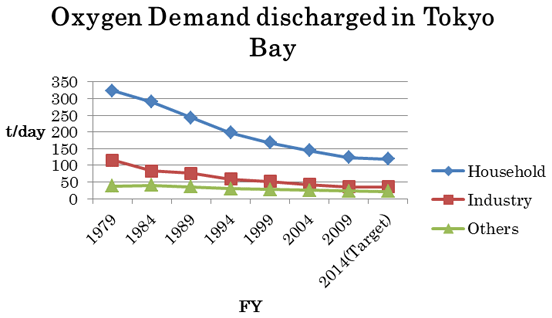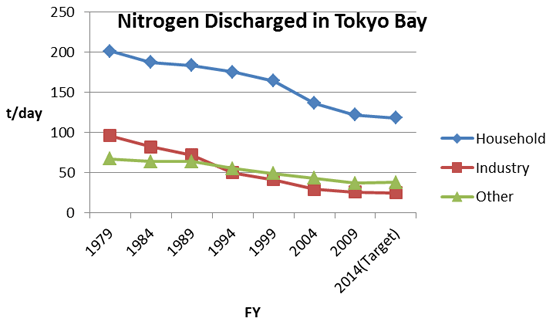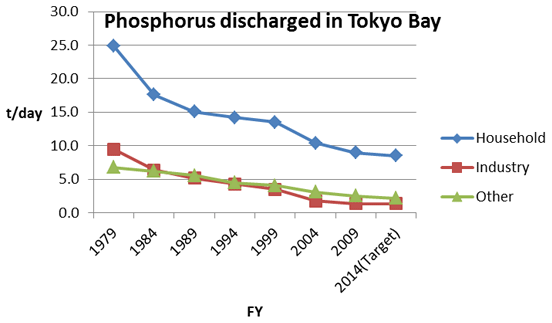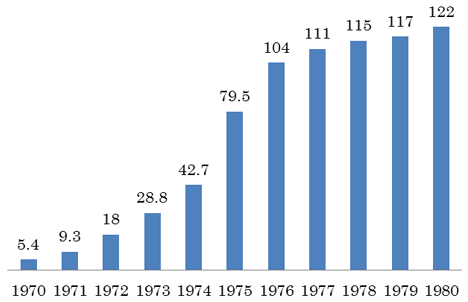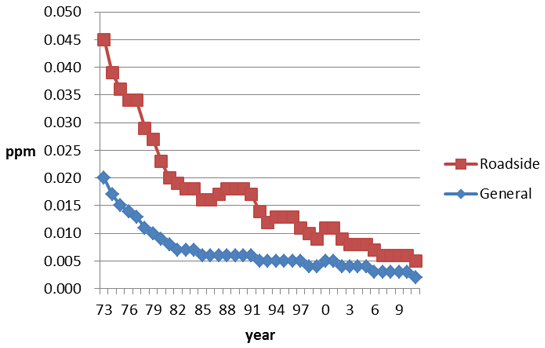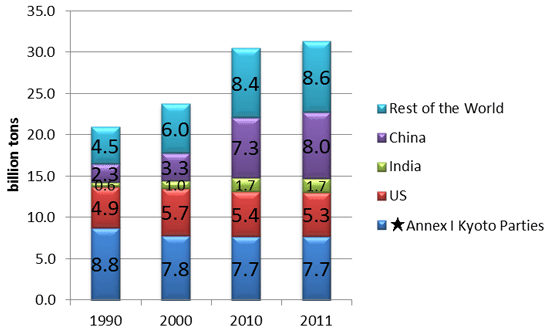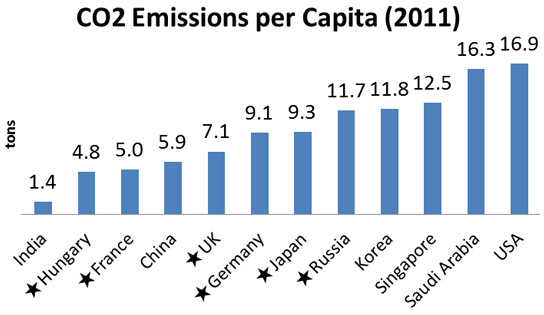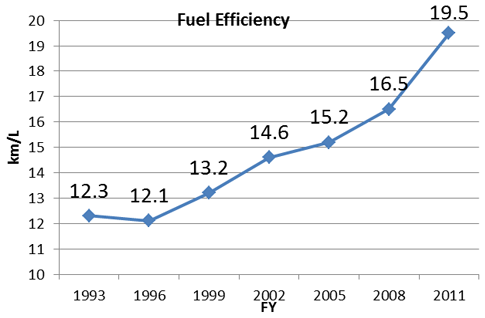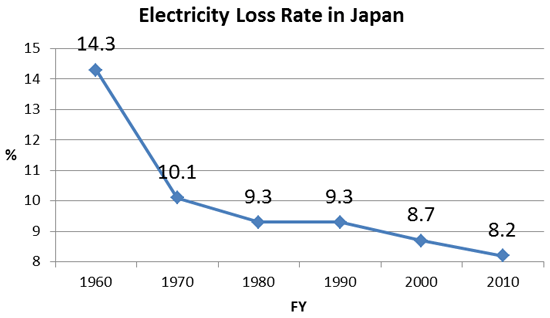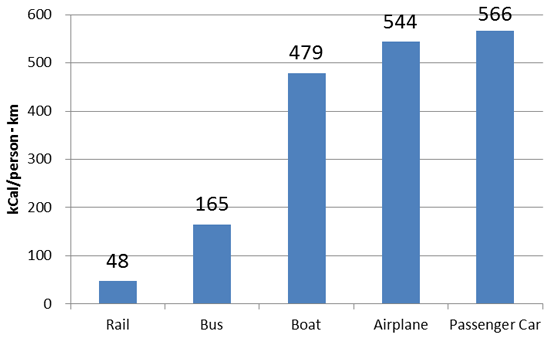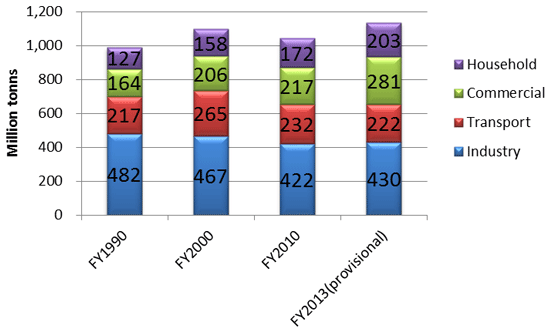Abstract要旨
This chapter focuses on water quality, air quality, and global warming, with the objective of providing a basic introduction to environmental policy in Japan(注1). Having experienced severe water and air pollution especially during the 1950s and 1960s, measures were taken, resulting in a reduction of pollutants during the 1970s and 1980s. Global warming became a very significant environmental problem in the 1990s.
この章は、水質、大気と地球温暖化に焦点を当て、日本の環境政策の基本的な事項を紹介する。特に1950年代と1960年代に水や大気の深刻な公害を経験し、対策がとられ、1970年代から1980年代にかけて汚染が減少した。1990年代には、地球温暖化が非常に重要な環境問題になった。
1. Introductionはじめに
Japan experienced severe problems associated with pollution. In the 19th century, local residents in the downstream part of the Watarase River suffered from pollution caused by a copper mine upstream. A booklet titled "Water Environmental Management in Japan" includes the details of such history(注2), together with overall policies and data related to the water environment in Japan.
日本は、激しい公害問題を経験した。19世紀、渡良瀬川下流の住民は、上流の銅鉱山による汚染に苦しんだ。「日本の水環境」という冊子に、水環境に関するこのような歴史や政策全体やデータが載っている。
The outbreak of the Minamata Disease, which occurred as a result of methylmercury poisoning, was first reported in 1956. People were affected after eating large quantities of fish that had ingested and accumulated methylmercury, after the toxin was discharged into Minamata Bay by chemical plants(注3).
1956年には、メチル水銀中毒の結果起きた水俣病の最初の例が報告された。化学工場から水俣湾に排出されたメチル水銀を魚が摂取して蓄積し、このような魚を多く食べた人々が被害を受けた。
During the 1960s, environmental pollution problems increased. For example, an increase in organic matter decreased oxygen levels in many rivers, bays, and lakes, creating a number of adverse effects for the local people including pungent odors, diminished fish population, and poisonous plankton and bacteria. Also, the number of asthmatic patients increased in certain areas close to large petrochemical factories. The air in the neighborhood was found to be polluted by sulfur oxide (SOx)(注4).
1960年代、環境問題は悪化した。たとえば、多くの川や湾や湖で増加した有機物が酸素を減らし、地域住民は悪臭、魚の減少、水中での毒のある浮遊生物や細菌の増殖に苦しんだ。また、大規模な石油化学工場付近の特定の地域でぜんそく患者が増加した。周辺の大気が硫黄酸化物で汚染されていた。
Thus, Japan's environmental policy was strengthened. The Basic Law for Environmental Pollution Control, legislated in 1967, was among the first "basic laws" in Japan, stating basic policy frameworks such as the role of different actors.
このため、日本は、環境政策を強化した。1967年に立法された公害対策基本法は日本の「基本法」の初期の1つで、さまざまな主体の役割など政策の枠組みを規定している。
In the 1990s, climate change became the focus of the environmental problems, and the Basic Law for Environmental Pollution Control was amended and became the Basic Environment Law in 1993. The Basic Environment Law includes provisions on the objectives, responsibilities of different actors, annual reports, the basic environment plan, environment quality standards, and the Environment Council, among others(注5).
1990年代には気候変動が環境問題の焦点となり、公害対策基本法は、1993年に改正されて環境基本法となった。環境基本法には、目的、さまざまな主体の責務、年次報告、環境基本計画、環境基準、中央環境審議会等についての規定がある。
The government strengthened its organization for the environment. The Environment Agency was established in 1971, and various policy measures were taken to reduce pollution during 1970s and 1980s.The Environment Agency became the Ministry of the Environment (MOE) in 2001. Since 2012, the responsibilities of the MOE have included water and air pollution control, waste management, nature conservation, global environment, and nuclear regulation(注6).
政府は環境のための組織を強化した。1971年には環境庁が設立され、1970年代から1980年代にかけて、さまざまな公害対策が行われた。環境庁は、2001年には環境省となった。2012年以降の環境省の任務には、水や大気汚染の管理、廃棄物の管理、自然保護、地球環境、原子力規制が含まれる。
Private companies also strengthened their functions for the environment in order to avoid problems including punishments from the government. The Act on the Improvement of Pollution Prevention Systems in Specified Factories, legislated in 1971, obliges specific kinds of factories to have managers with government licenses to be in charge of pollution control(注7).
民間企業も、政府による罰を含む問題を回避するため、環境のための機能を強化した。1971年に立法された特定工場における公害防止組織の整備に関する法律は、一定の種類の工場に、国の資格を持つ公害防止の管理者を置くことを義務づけている。
2. Protecting Environmental Quality of Water水質保全
2-1 Regulations on Effluents排水規制
In order to regulate effluents discharged by factories and other establishments, the Water Pollution Control Law was legislated in 1970(注8). Also, in order to impose more stringent regulations in the Seto Inland Sea areas where pollution was more serious, the Interim Law for Conservation of the Environment of the Seto Inland Sea was legislated in 1973. The Seto Inland Sea is the body of water located between the main island of Honshu and the islands of Shikoku and Kyushu, which, at the time, needed special measures to limit the total amount of pollutants. The interim law became permanent in 1978. In order to reduce pollution in lakes such as Lake Biwa, which provides water for many people including those living in Kyoto and Osaka, the Law Concerning Special Measures for the Conservation of Lake Water Quality was legislated in 1984.
工場などの事業場からの排水を規制するため、水質汚濁防止法が1970年に立法された。また、より汚染が深刻であった瀬戸内海地域の規制を強化するため、瀬戸内海環境保全臨時措置法が1973年に立法された。瀬戸内海は、主な島である本州と、四国、九州の間の水域で、当時、汚濁物質の総量規制が必要とされた。臨時措置法は1978年に恒久法となった。大阪の住民など多くの人々の水源である琵琶湖などの湖の汚染を減らすため、1984年には湖沼水質保全特別措置法が立法された。
The central government and local governments cooperate closely to protect water quality in accordance with the three laws (Water Pollution Control Law, Law Concerning Special Measures for Conservation of the Environment of the Seto Inland Sea, Law Concerning Special Measures for Conservation of Lake Water Quality). The laws have many provisions, among which are regulations covering the level of pollutants in effluents. Most of the regulatory administration is carried out by local governments. Local governments can establish regulations that are more stringent than the national regulations.
国と地方自治体は、三法(水質汚濁防止法、瀬戸内海環境保全特別措置法、湖沼水質保全特別措置法)に従って水質保全で緊密に協力する。これらの法には、排水の汚濁水準の規制など多くの規定がある。規制行政の大部分は地方自治体が行う。地方自治体は、国の規制より厳しい規制を行うこともできる。
Under the Water Pollution Control Law, the MOE sets standards for effluents from factories and other commercial facilities that discharge wastewater into public waters such as seas, rivers, and lakes(注9).
水質汚濁防止法に基づき、環境省は、海、川、湖のような公共水域に排水を出す工場その他の事業場の排水基準を設定する。
There are two categories for effluent standards. One category is related to the protection of human health and includes standards on pollutants such as mercury and cadmium, which can cause diseases. Another is related to the protection of the living environment and includes standards such as Biochemical Oxygen Demand (BOD) and Chemical Oxygen Demand (COD), which are indicators of water quality for organic contamination. High levels of organic contamination can cause a shortage of oxygen in the water. This category also includes nitrogen and phosphorus, which act as fertilizers to increase the growth of undesirable plankton and algae.
排水基準には2つの区分がある。1つは人の健康に関するものである。これは、水銀やカドミウムなど、病気の原因となりうる汚染物質の基準を含む。もう1つは生活環境に関するものである。これは、有機物による汚染を示す水質の指標である生物化学的酸素要求量(BOD)や化学的酸素要求量(COD)を含む。有機物による高水準の汚染は、水中の酸素不足を起こす可能性がある。この区分には、望ましくない浮遊生物や藻の繁殖を増やす肥料となる窒素や燐も含まれる。
Stricter standards are applied to some areas. For example, total volumes of some pollutants are regulated, in addition to the densities, in Tokyo Bay, Ise Bay, and the Seto Inland Sea. Also, local governments in some areas set effluent standards to be stricter than the uniform national standards.
一部の水域では、より厳しい基準が適用される。たとえば、東京湾、伊勢湾、瀬戸内海では、濃度に加え、一部の汚濁物質の総量が規制される。また、一部の地域の地方自治体は、国の統一的基準よりも厳しい排水基準を設定している。
Those who manage factories and other commercial facilities which discharge effluents are obliged to measure the pollution level of the effluents and keep records of the measurements in accordance with the order issued by the MOE. The Minister of the Environment, prefectural governors, and mayors of designated cities request reports from factories and other commercial facilities on their effluents, and conduct on-site inspections when necessary. If it is found that any effluent violates the standards, punishment may be enforced. Also, an order may be issued to modify the construction of the facility or the method of wastewater treatment(注10).
排水する工場などの事業場は、環境省令に従って排水の汚濁水準を測定し結果を保存しなければならない。環境大臣、知事、指定された市の市長は、必要があれば、工場その他の事業場から排水に関する報告を求め、立ち入り検査をすることができる。もし排水が基準に違反していれば、罰則を執行することができる。また、施設の構造や排水処理の方法を変更する命令を出すこともできる。
Regulations are effective only when proper enforcement is carried out. In order to ensure proper enforcement, the MOE surveys the enforcement of all three laws, and publicizes the results. In FY2011, the number of facilities subject to effluent control totaled 266,860, including 65,648 hotels, 30,280 car washes, and 28,968 livestock farms. Of these facilities, 38,882 were subject to on-site inspections resulting in 7,650 cases of administrative guidance. Twelve administrative orders were issued to improve the situation, and eight infringements of effluent standards were found(注11).
規制は、適切に執行されてはじめて効果を上げる。適切な執行を確保するために、環境省は、三法の施行を調査し発表する。2011年度には、26万6860の事業場が排水管理の対象で、そのうち6万5648はホテル、3万0280は洗車、2万8968は畜産農業だった。これらの施設のうち、3万8882件で立ち入り検査が行われ、7650の行政指導が行われた。状況を改善するために12の行政命令が出され、排出基準違反は8件あった。
2-2 Policy Measures for Household Wastewater生活排水対策
Effluents containing pollutants such as organic matter, phosphorus, and nitrogen from household activities have been a major cause of pollution of public waters, especially around big cities. In order to treat wastewater from households, the government has been promoting the construction of sewage systems. For local governments operating sewage systems, financial support was provided by the central government. Also, the central government and local governments jointly subsidize the Japan Sewage Works Agency, which has been providing technical support on sewage systems to local governments(注12). For areas without sewage systems, mostly in mountainous areas or areas with low population densities, rural community wastewater treatment facilities and household wastewater treatment facilities, called johkaso (septic tank), have been developed with the aid of subsidies.
有機物、リン、窒素などの汚染物質を含む生活排水は、特に大都市周辺などの公共水域の汚濁の大きな要素であった。家庭からの排水を処理するため、政府は下水の設備建設を促進した。下水道を整備する地方自治体に対して、国からの財政的支援が行われてきた。また、国と地方自治体から補助金が出されている下水道事業団が、地方自治体に対して下水道に関する技術支援を行ってきた。下水のない地域は、主に山間部か人口密度の低い地域であり、農業集落排水施設や浄化槽と呼ばれる家庭用の排水処理設備が、排水処理のために開発されて施設建設には補助金が出される。
In order to reduce pollution from households, efforts have been made to disseminate information on water quality so as to raise public awareness. The MOE and local governments have created various publications and websites and have called for a more environmentally sound use of water. Along with the heightened public awareness, producers of detergents have changed their products to those which are less harmful to the environment. For example, detergents without phosphorus were developed in the 1970s, and most of the detergents in Japan do not contain phosphorus today.
家庭排水からの汚染を減らすため、水質についての情報を広めて国民の意識を高める努力が行われている。環境省と地方自治体はさまざまな出版物やホームページを作り、環境に配慮した水の使用を呼びかけてきた。国民の意識向上とともに、洗剤の製造者は、環境への悪影響の少ない製品に、商品を変更してきた。たとえば、1970年代に無燐洗剤が開発され、現在日本のほとんどの洗剤は無燐になっている。
Through the above-mentioned measures, pollution from households was reduced. For example, oxygen demand, nitrogen, and phosphorus discharged from households, industry, and other (including agriculture, stockbreeding, and fishery) sectors in Tokyo Bay were reduced as shown in Figures 1, 2, and 3, in spite of the increase in population and economic activities in the neighboring area.
上記によって、生活排水からの汚染は削減された。たとえば、周辺の人口や経済活動が拡大したにもかかわらず、東京湾への生活排水、産業、その他(農業、畜産、漁業など)からの排水の酸素要求量、窒素、リンは、図1、2、3のように低減した。
2-3 Monitoring and Publicizing Water Quality水質の監視と公表
Local governments monitor the quality of water in seas, rivers, lakes, and groundwater, according to the common items and methods set by the MOE, and compare them with environmental quality standards. Studies are made on each point where any substance exceeds the standard, and measures are taken to meet the standard. The MOE collects and publicizes the results and other information related to water quality so as to raise public awareness and encourage further action to protect the environment.
地方自治体が、環境省が決めた共通の項目と方法に従って、海、河川、湖沼、地下水の水質を監視し環境基準と比較する。いずれかの項目で基準を超過した地点ごとに調査が行われ、基準を達成するための対策がとられる。環境省は、監視結果とその他の水質関係の情報を集めて公表し、国民の意識を高めて、環境保全のための一層の行動を奨励する。
Water quality improved, and the non-compliance rate of the standards on human health items declined rapidly during the 1970s(注16). Most of the excesses in human health items had been handled, and most of that still remaining were found to be from natural causes, such as high arsenic contents in nearby rocks or soil. Monitoring continues for sites in which the cause of the excess has not been determined(注17).
水環境は改善し、人の健康に関する項目の基準違反率は、1970年代に急速に低下した。人の健康に関する項目の大部分は既に対策がとられ、残っている超過地点の大部分は、近隣の岩石か土壌の砒素含有量が高いなどの自然起因である。調査原因が不明の地点では、監視を継続する。
Organic contamination, which is measured by oxygen demand, improved in most rivers, but improvements in lakes were smaller, as shown in Figure 4.
酸素要求量によって計測される有機物による汚染は、図4にみられるように、ほとんどの川で改善したが、湖での改善はより少なかった。
図4 日本の環境基準の達成状況(生物化学的酸素要求量又は化学的酸素要求量)
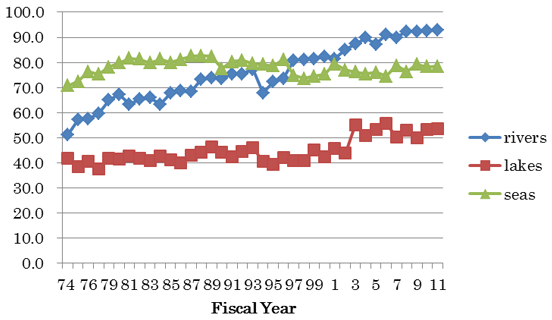
In order to encourage efforts to make further improvements, all rivers and lakes are ranked by water quality in terms of organic contamination, and the top five cleanest and top five dirtiest rivers and lakes are determined. These rankings are publicized so as to raise awareness of the water environment. In addition, the top five rivers and lakes which had the largest improvements in water quality are also publicized, so as to recognize the efforts that have been made. Sightseeing businesses on rivers and lakes are especially interested in raising the ranking for their sites. In addition to the annual publication by the MOE, a website on water quality has been established to show information on water quality to the public(注19).
一層の改善を奨励するため、すべての河川と湖沼が水質によって順位付けられ、水質の有機汚濁の観点から最もきれいな5つと最悪の5つが決定される。これらの順位は、水環境についての認識を高めるために公表されている。また、水質改善のために行われた努力を認識するため、最も水質が改善された5つも公表される。河川や湖沼の観光業者は、その地域の順位に特に関心を持つ。環境省による毎年の発表に加え、水質に関する情報を一般に提供するサイトが作られている。
Swimming beaches pose a good opportunity for raising awareness in water quality among the public and local business community. In the beginning of summer each year, the water quality of swimming beaches is graded and publicized. If any beach is found to be lower than the lowest passing grade, swimming is not allowed(注20). Also, in 2006, the MOE selected the 100 best beaches and publicized information related to their environment, access, etc., through its website(注21). Although the website is in Japanese, pictures and local maps can be seen by clicking on the beaches in the map.
水浴場も、住民や地域の産業界の水質に関する認識を向上させる良い機会を提供する。毎年夏の初めに、水浴場の水質の等級がつけられて公表される。もし最低の合格等級以下であれば、そこで泳ぐことは禁止される。また、2006年に環境省によって100の最高の水浴場が選ばれ、これらの環境、交通手段等に関する情報が環境省のホームページで公表された。ホームページは日本語だが、地図の水浴場をクリックすれば写真や地図などが見られる。
As for groundwater, regular measurements are made by prefectures and the results and causes of pollution are publicized by the MOE. In FY2013, for general monitoring, groundwater from 3,692 wells was measured, among which 218 (5.9% of the total) contained substances exceeding the environmental quality standards. Among these 218 wells, the largest number, 117, had nitrate nitrogen/nitrite nitrogen in excess of the standard(注22). Such wells are often found in areas where a large amount of fertilizer is used or manure from livestock is not treated properly. Household wastewater also causes such pollution. Since babies who are drinking water with excessive nitrate nitrogen/nitrite nitrogen can suffer from anemia, environmentally sound management is called for in agriculture and stockbreeding, so as to emit less nitrogen into the groundwater. In addition, follow-up monitoring is conducted on wells which have exceeded the standards in the past and other wells located around them. In FY2013, 9,723 wells in total were monitored.
地下水は、都道府県によって定期的に測定され、結果や汚染原因が環境省によって公表されている。2013年度の概況調査では3692の井戸の地下水が測定され、うち218(5.9%)の井戸で環境基準を越えた物質があった。この218の井戸のうち最大である117では硝酸性窒素/亜硝酸性窒素が基準を超過していた。このような井戸は、肥料を多用したり家畜の糞尿が適切に処理されていなかったりする地域でよくみられる。生活排水もこのような汚染の原因となる。硝酸性窒素/亜硝酸性窒素が過剰な水を飲んでいる乳児は貧血になるおそれがあるため、農業や畜産での環境に配慮した管理によって地下水に排出する窒素を減らすことが求められる。概況調査のほか、基準を超えた井戸の周辺の井戸や過去に基準を超過した井戸の継続調査も行われ、2013年度は合計で9723の井戸が調査された。
2-4 Policies Related to River Management, Drinking Water, and Non-point Sources河川管理、水道、面源関係の政策
The 1997 amended River Law added improvement and conservation of the environment to the list of the fundamental tasks of river administration under the Ministry of Land, Infrastructure, Transport and Tourism(注23). Projects have been carried out to improve water quality and protect the natural environment. For example, water in some dam lakes is purified by aeration (mixing air into water)(注24). The Japan Water Agency, which is responsible for water resource development such as dam construction in major river systems in Japan, carries out related environmental activities such as aeration and installation of partitioning fences to prevent the growth of algae(注25).
1997年に改正された河川法は、環境の改善と保全を国道交通省の河川管理の基本的な仕事の1つに加えた。水質改善と自然環境保全のために、いくつかのプロジェクトが実施されている。たとえば、一部のダムでは、通気(空気を水に混ぜる)による水質浄化が行われている。日本の主要な水系でのダム建設などの水資源開発を任務とする水資源機構は、通気や藻の繁殖を防ぐフェンスの設置など、関連する環境活動を行っている。
Efforts by public organizations to protect the quality of drinking water are important, too. To this end, the Drinking Water Sources Law and the Law concerning Special Measures for Water Quality Conservation at Water Resources Area in Order to Prevent the Specified Difficulties in Water Utilization(注26) were established in 1994. The Ministry of Health, Labour and Welfare publicizes activities by municipalities to protect drinking water sources(注27).
飲料水の水質保全のための公的な組織の努力も重要である。このため、水道原水水質保全事業法と水道水源特別措置法が1994年に創設された。厚生労働省は、市町村による水道水源の保全の取り組みを発表している。
Problems remain in water quality in some lakes. The Lake Water Study Committee of the MOE agreed that additional action was needed in 2004 because water quality in lakes in terms of oxygen demand was not satisfactory. In 2005, the Law Concerning Special Measures for the Preservation of Lake Water Quality was amended, to include measures to reduce pollution from non-point sources such as agriculture. For example, more appropriate use of fertilizers is encouraged in certain areas designated under the law to reduce the inflow of nitrogen and phosphorus to lakes. The amended law also includes measures to preserve the natural vegetation around lake shores, which is effective for improving the quality of water.
一部の湖沼の水質に問題が残っている。湖沼で酸素要求量からみる水質改善が不十分だったため、環境省の湖沼研究会は2004年に追加的対策の必要性に合意した。2005年、湖沼水質保全特別措置法が改正され、農業などの面源対策が追加された。たとえば、法で指定された地域では、窒素や燐の湖沼への流入を減らすため、肥料のより良い使い方が奨励される。改正された法律には、水質保全に効果がある湖岸の植生の保全対策も含まれる。
3. Protecting Environmental Quality of Atmosphere 大気環境の保全
3-1 Reducing Emissions from Facilities事業場からの排出削減
Air pollutants are generated mainly from facilities such as factories and mobile sources such as motor vehicles. Major problems during the 1960s and 1970s were caused by soot and smoke from factories. In order to reduce air pollution, the Air Pollution Control Law was legislated in 1968(注28). The law has provisions to protect air quality by measures such as those to control emissions of soot and smoke and particulate matters from factories.
大気汚染物質は、工場などの施設や、自動車などの移動源から主に発生する。1960-70年代に主に問題になったのは、工場からの煤煙だった。大気汚染を削減するため、大気汚染防止法が1968年に立法された。この法は、工場からの煤煙や粉塵の排出を管理することなどにより大気の質を保全するための規定を有している。
As for factories, national emission standards are set by the Minister of the Environment, but prefectural governors can set more stringent standards in areas under their jurisdiction. Regulation duties are conducted by prefectures and large cities.
工場については、環境大臣が国の排出基準を決めるが、県知事がそれぞれの地域でより厳しい基準を設定することもできる。規制の業務は県や大きな市が行う。
Any person who plans to establish a soot and smoke emitting facility must provide information such as the kind of proposed facility to the governor of the prefecture. If the governor finds that the estimated volume and concentration of the soot and smoke fails to meet the emission standard, he or she may order the notifying person to modify the plan.
煤煙発生施設を作ろうとする者は、施設の計画などの情報を都道府県知事に提出しなければならない。知事は、予想される煤煙の発生量か濃度が環境基準を超えると判断すれば、計画の変更を命じることができる。
Those who manage facilities that emit soot and smoke must measure and keep record of the volume and concentration of the soot and smoke generated according to the technical standards set by the MOE. If the governor of the prefecture finds that the emission is likely to exceed the standards continuously, he or she may order the person to improve the method of operation.
煤煙発生施設の管理者は、環境省が設定した技術的基準に従って、発生した煤煙の量と濃度を測定し記録を保存しなければならない。知事は、発生が持続的に基準を上回る可能性が高いことを知ったら、その者に管理の改善を命じることができる。
In order to ensure proper enforcement of the law, the MOE surveys the status of enforcement and publicizes it annually. For example, in FY2012, the number of notifications from soot and smoke emitting facilities was 217,132, among which 62.9% were boilers, 16.6% were diesel engines, and 4.4% were gas turbines. Onsite inspections were conducted at 23,498 facilities, of which 4,136 cases of administrative guidance were made, and one administrative order was issued(注29).
適切な法執行を確保するため、環境省は執行状況を監視し毎年発表する。たとえば2012年度、煤煙発生施設の届出件数は21万7132で、うち62.9%はボイラー、16.6%はディーゼル機関、4.4%はガスタービンだった。立ち入り検査は2万3498件行われ、行政指導は4136件行われ、行政命令は1件あった。
Other laws regulating special facilities are also used for protecting air quality. For example, the Electricity Business Act(注30) has provisions for regulating power plants, and are used to ensure that the emissions from fossil fuel combustion in power plants do not exceed certain limits.
特別な施設についての他の法律も、大気の質を守るために使われる。たとえば、電気事業法には発電所を規制する規定があり、発電所での化石燃料の燃焼からの排気が一定の基準を超えないようにするために使われている。
In addition to environmental regulations, special loans were provided by governmental financial institutions for environmental investments to encourage factories to install facilities to reduce pollution, especially during the 1970s when such financial needs for environmental investments were high. During this period, the capacity of SOx removal facilities, for example, increased rapidly, as shown in Figure 5.
環境規制に加え、特に1970年代、環境投資への資金需要が高かった時期には、政府系金融機関による特別融資が工場の公害削減装置の設置を促した。この時期、たとえば図5にみられるように、脱硫装置は急激に増加した。
3-2 Reducing Air Pollution from Mobile Sources 移動発生源からの大気汚染の削減
Although the regulation on factories effectively reduced pollution from factories during the 1970s, air pollution worsened during the 1980s mainly in roadsides because of the increased number of automobiles. In order to mitigate roadside air pollution from mobile sources, the Air Pollution Control Law has provisions including utilizing other laws to protect air quality. Major actions under the law include the following:
工場からの公害が規制により1970年代に効果的に削減されたにもかかわらず、1980年代、自動車の増加によって、大気汚染は特に道路付近で悪化した。道路に面した場所の移動源からの大気汚染を軽減するために、大気汚染防止法は大気の質を守るために他の法律を使う規定を含んでいる。この法に基づく主な行動には、以下が含まれる。
- The Minister of the Environment establishes maximum permissible limits on the amount of exhaust gases from motor vehicles and also from non-road special motor vehicles such as construction machinery.
-環境大臣は、自動車の排気について許容限度を設定するとともに、建設機械など道路関係以外の特定特殊自動車の排気ガスについての許容限度も設定する。
- The Minister of Land, Infrastructure, Transport and Tourism establishes necessary matters on the control of emissions of motor vehicles exhaust under the Road Transportation Vehicles Act, ensuring to secure the maximum permissible limits set by the Minister of the Environment. Automobiles which emit exhaust gas exceeding the limit are not allowed to be sold, and do not pass periodical car inspections.
-国土交通大臣は、環境大臣が設定した許容限度を確保するように、道路運送車両法に基づく自動車の排気ガス管理に必要な事項を設定する。上限を超える排気ガスを排出する自動車は販売できず、定期的な車検を通らない。
- The Minister of the Environment sets maximum permissible limits on the quality of automobile fuel where necessary to prevent air pollution caused by automobile exhaust gases. For example, regulation on the sulfur content in diesel oil has been strengthened as shown in Table 1.
- 環境大臣は、自動車の排気ガスによる大気汚染を防ぐために必要があるときは、自動車の燃料の質についての許容限度を設定する。たとえば、軽油に含まれる硫黄の規制の推移は、表2のとおり強化されてきた。
| Year 年 | 1976 | 1992 | 1997 | 2004 | 2007 |
|---|---|---|---|---|---|
| Sulfur content (ppm) 硫黄分 | 5,000 | 2,000 | 500 | 50 | 10 |
- The Minister of Economy, Trade and Industry establishes necessary matters concerning the regulation of automobile fuel by an order under the Act on the Quality Control of Gasoline and Other Fuels, ensuring to secure the maximum permissible limits set by the Minister of the Environment. Gasoline and other fuels which contain more sulfur and other pollutants than the limits are not allowed to be sold.
- 経済産業大臣は、環境大臣が設定した許容限度を確保するように、揮発油などの品質の確保に関する法律に基づく命令で自動車燃料の規制に関する必要な事項を定める。上限を超える硫黄などの汚染物質を含むガソリンその他の燃料は、販売を許されない。
In order to further mitigate emissions from motor vehicles, the Law Concerning Special Measures for Total Emission Reduction of Nitrogen Oxides and Particulate Matters from Automobiles in Specified Areas was legislated in 2001, by amending the Law Concerning Special Measures for Total Emission Reduction of Nitrogen Oxides from Automobiles in Specified Areas ("Particulate Matters" was added to the title of the law). Under the fundamental plans to reduce the total volume of nitrogen oxides and particulate matters emitted from automobiles, special restrictions are set in areas of large concentrations of motor vehicles such as the Tokyo Metropolitan area. Only automobiles that emit nitrogen oxides and particulate matters below the level of certain standards, which are more stringent than the national standards, are allowed in these areas.
自動車からの排出を一層削減するため、2001年に「自動車から排出される窒素酸化物及び粒子状物質の特定地域における総量の削減等に関する特別措置法」が「自動車から排出される窒素酸化物質の特定地域における総量の削減等に関する特別措置法」の改正により制定された(名称に「粒子状物質」が加えられた)。自動車からの窒素酸化物と粒子状物質の総量を減らすための基本計画の下で、東京都など多くの車両が集中する地域では特別な規制が作られた。これらの地域では、窒素酸化物や粒子状物質の排出が国全体の基準より少ない自動車しか許容されない。
Regulations are revised or added when necessary. For example, new regulations over volatile organic compounds (VOCs) started in 2006(注33).
規制は必要に応じて変更又は追加される。たとえば、2006年には揮発性有機化合物の新しい規制が始まった。
3-3 Compensation for Health Damages Caused by Air Pollution 大気汚染による健康被害の補償
Since many factories and automobiles caused air pollution, it was difficult to decide the amount of compensation to be paid to and by the parties involved. The Act on Compensation, etc. of Pollution-related Health Damage, legislated in 1973, improved the situation. The law has provisions to designate areas severely affected by air pollution and diseases caused by air pollution such as asthma and bronchitis. Patients of the designated diseases in the designated areas are compensated, and 80% of the money is provided by facilities emitting SOx, collected in accordance with the amount of SOx emission, and 20% is provided by taxation on automobiles. Since air pollution was reduced, designation of the areas ended in 1988, and only patients who had been acknowledged up to that time have been compensated since then.
多くの工場や自動車が大気汚染の原因であるため、誰がどのくらい誰に補償を払わなければならないか決定することが困難だった。1973年に立法された公害健康被害補償法は、この状況を改善した。この法には、大気汚染が深刻な地域と、ぜんそくや気管支炎など大気汚染で起きる病気を指定する規定がある。指定された地域の指定された病気の患者は補償され、その金額の80%はSOxを排出する施設からSOxの排出量に応じて集められるお金から、20%は自動車への課税から支払われる。大気汚染が減少したため、地域指定は1988年に終わり、その後は、その時までに認定された患者だけが補償されている。
3-4 Monitoring and Publicizing Air Quality大気の質の監視と公表
Atmosphere quality is measured at monitoring stations mostly by local authorities. There are two types of stations: roadside air pollution monitoring stations and ambient air pollutions monitoring stations (general stations). There were 422 roadside stations and 1,489 general stations as of the end of March 2012(注34).
大気の質は、測定局で大部分は地方自治体によって測定される。測定局には2種類ある。自動車排出ガス測定局と、一般環境大気測定局である。2012年3月末には、422の自排局と1489の一般局があった。
Data on air quality are publicized by the MOE through the homepage of the Atmospheric Environmental Regional Observation System(注35). The system has a nickname called "Soramame-kun," and efforts have been made to make it interesting to the public. Although the homepage is in Japanese, data can be seen relatively easily by non-Japanese speakers by clicking on any part of the map.
大気の質に関するデータは、環境省の大気汚染物質広域監視システムのホームページで公表される。このシステムには「そらまめくん」という愛称があり、国民が関心を持つよう工夫されている。このホームページは日本語だが、地図の好きな部分をクリックすると、日本語を使わない人でも比較的簡単にデータを見ることができる。
Through the measures mentioned above, concentrations of pollutants in the atmosphere have decreased over the years, in spite of economic growth and an increase in the number of automobiles. The average annual concentration of SO₂, NO, NO₂, and SPM in the atmosphere dropped, as shown in Figures 6, 7, and 8. In this century, Japan is among the countries where emissions of SOx and NOx are the lowest in the world, as shown in Table 2.
前述のような方法で、経済成長や自動車の増加にもかかわらず、大気汚染は減少していった。図6、7、8が示すように、大気中のSO₂、NO、 NO₂ and SPMの年平均値は減少した。表2が示すように、今世紀では、日本は、SOx、NOxの排出が世界で最も少ない国の1つである。
図7 日本の一酸化窒素と二酸化窒素濃度の年平均の変化
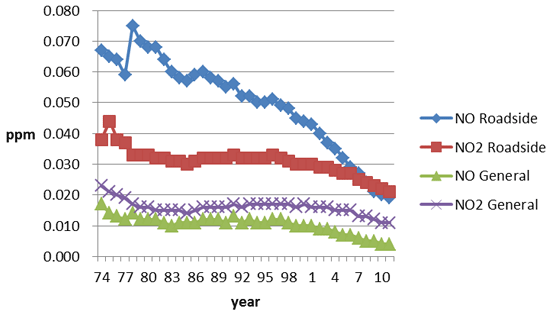
図8 日本の浮遊粒子状物質の年平均の変化
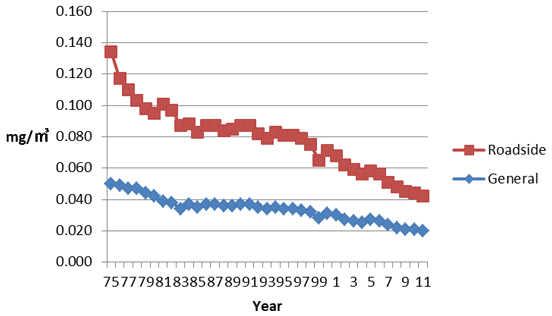
| (Intensities per GDP: kg/1,000USD, Intensities per capita: kg/person.) | ||||||
| U.S. | Korea | France | UK | Germany | Japan | |
|---|---|---|---|---|---|---|
| SOx(kg/GDP) | 0.7 | 0.3 | 0.2 | 0.2 | 0.2 | 0.2 |
| NOx(kg/GDP) | 1.0 | 1.0 | 0.6 | 0.5 | 0.5 | 0.5 |
| SOx(kg/person) | 27.8 | 8.3 | 6.5 | 4.8 | 5.5 | 6.0 |
| NOx(kg/person) | 43.3 | 24.5 | 17.8 | 17.8 | 16.7 | 14.0 |
Since the enactment of the Law Concerning Special Measures for Total Emission Reduction of Nitrogen Oxides and Particulate Matters from Automobiles in Specified Areas in 2001, pollutants from domestic sources have been further reduced.
2001年の「自動車から排出される窒素酸化物及び粒子状物質の特定地域における総量の削減等に関する特別措置法」の施行以降、国内の発生源からの汚染は一層減少した。
Recent problems in air pollution concern PM2.5 (particulate matters with diameter less than 2.5 micro meters). Sources of PM2.5 are often beyond national boundaries, and measures to reduce such pollution involve international cooperation.
最近の大気汚染の問題は、PM2.5(直径が2.5マイクロメートル以下の粒子状物質)である。PM2.5の発生源は往々にして国境の外にあり、汚染を減らす対策は、国際協力を含む。
4. Protecting the Earth from Climate Change気候変動から地球を守る
4-1 International Agreements to Reduce Greenhouse Gases 温室効果ガス削減の国際合意
In 1992, an agreement was reached for the United Nations Framework Convention on Climate Change. It is an international treaty to consider what could be done to limit climate change, and to cope with the impacts(注40).
1992年、国連気候変動枠組条約が合意された。これは、気候変動を限定し、その影響を制限するために何ができるか検討するための国際条約である。
In 1997, Japan hosted the Third Conference of the Parties for the United Nations Framework Convention on Climate Change in Kyoto, at which the Kyoto Protocol(注41) was reached. The Kyoto Protocol included numerical targets of greenhouse gas emissions reduction for some countries during its first commitment period (2008-2012) compared to 1990 levels.
1997年に日本は国連気候変動枠組条約の第三回締約国会議をホストし、そこで京都議定書が合意された。合意された京都議定書は、一部の国々の第一約束期間(2008-2012)における温室効果ガス排出を1990年に比較して減らす数値目標を含んでいた。
Figure 9 shows CO₂ emissions from fuel combustion in the world. Figure 10 shows CO₂ emissions from fuel combustion per person for selected countries in 2011. Countries marked with ★ are those which committed themselves to the numerical target for the first commitment period under the Kyoto Protocol.
図9は、世界の燃料燃焼からのCO₂排出を示している。図10は、一部の国の2011年の1人当たりの燃料燃焼からのCO₂排出を示している。★をつけた国々は、京都議定書の第一約束期間の数値目標にコミットした国々である。
Efforts have been made in Japan to meet the target. In 1998, the Act on Promotion of Global Warming Countermeasures was legislated(注44). The law prescribes responsibilities of the central government, local governments, businesses, and citizens to cope with global warming. The central government established the Kyoto Protocol Target Achievement Plan based on the law.
日本において目標達成のための努力が行われてきた。1998年、地球温暖化対策の推進に関する法律が立法された。この法律は、政府、地方自治体、事業者、市民の地球温暖化対策における責務を規定している。政府はこの法律に基づき「京都議定書目標達成計画」を策定した。
In order to raise awareness on global warming among the public, the MOE has been carrying out national campaigns and calling for action. For example, a campaign promoting a lifestyle to reduce CO₂ emissions called "Team Minus 6%" started in 2005. It called for actions such as a reduction in the use of air conditioning and the promotion of eco-driving. It also encouraged "COOL BIZ," which promotes a "business style" of dressing for working in offices at a comfortable temperature of 28 degrees Celsius(注45).
環境省は、地球温暖化についての公衆の認識を高めるキャンペーンを行い、行動を呼びかけてきた。たとえば、2005年には、CO₂を減少させるライフスタイルを振興する「チーム・マイナス6%」と呼ばれるキャンペーンが始まった。これは、エアコンの使用を減らすなどの行動をとるよう呼びかけ、エコ・ドライブを推奨した。また、摂氏28度でも快適に働けるビジネススタイルである「クールビズ」を奨励した。
Although Japan has not committed itself to the numerical target of the second commitment period of the Kyoto Protocol, efforts are continuing to further reduce greenhouse gas emissions.
日本は、京都議定書の第二約束期間にはコミットしていないが、温室効果ガスを削減する努力は続いている。
4-2 CO₂ , Economy, and Energy CO₂, 経済とエネルギー
Figure 11 shows CO₂ emissions per GDP. Since a large proportion of the anthropogenic emissions of greenhouse gases are CO₂ emissions from fossil fuel combustion, a reduction in the use of fossil fuels by energy conservation is effective to mitigate global warming and also contributes to the economy.
図11は、GDP当たりのCO₂排出である。人為的に発生した温室効果ガスの大部分は化石燃料の燃焼によるCO₂であるため、省エネルギーによって化石燃料の使用を減らすことは地球温暖化の緩和に有効であるとともに、経済にも役立つ。
図11 GDP当たりのCO₂排出
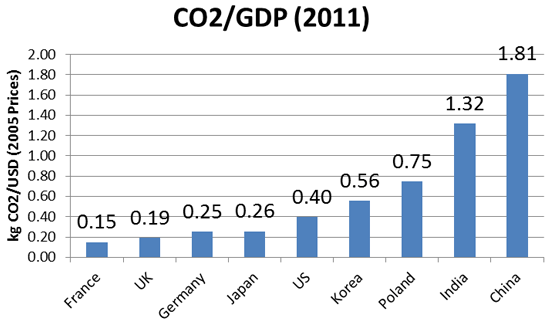
As shown in Figure 12, Japan is one of the countries where less energy is used per unit of GDP. Energy conservation in Japan has contributed not only to the reduction of greenhouse gases, but also to the protection of the economy and the people from higher energy prices.
図12にみられるように、日本はGDP1単位当たりのエネルギー使用が少ない国の1つである。日本での省エネルギーは、温室効果ガスの削減に役立つのみならず、より高いエネルギー価格から経済や人々を守るためにも貢献してきた。
図12 GDP1単位あたりのエネルギー使用
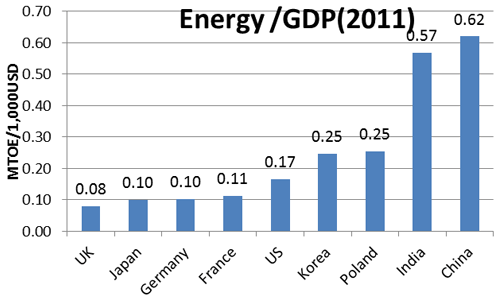
The other side of the energy use per GDP is GDP per energy use. Most countries have been making progress in achieving an increase in GDP per energy use, as shown in Figure 13. Japan stepped up energy efficiency and achieved rapid economic growth during the 1970-80s when the world economy was hit by an increase in oil prices. Its GDP per energy use stepped back during the 1990s, but is making progress through policies on climate change in this century.
GDP当たりのエネルギー使用の裏側は、エネルギー使用当たりのGDPである。図13にみられるように、ほとんどの国は、エネルギー当たりGDP増加達成に向けて進展してきた。日本は1970-80年代、世界経済が石油価格の急増で打撃を受けた時に、省エネルギーを大きく進め、高度経済成長を遂げた。そのエネルギー使用当たりのGDPは1990年代には後退したが、今世紀、気候変動政策を通じて拡大しつつある。
図13 エネルギー使用当たりのGDP
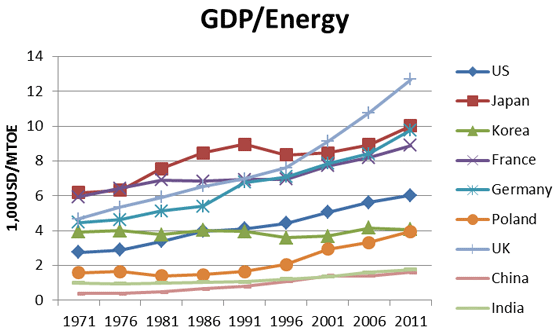
Per Total Primary Energy Supply measured in tons of oil equivalent
The Act on the Rational Use of Energy, which was created in 1979 during the second energy crisis, is used in the reduction of CO₂ emissions from energy sources. It is used to implement the measures required for the rational use of energy with regard to factories, transportation, buildings, and machinery and equipment(注49).
エネルギー源からのCO₂排出を減らすために、第二次石油危機の1979年に作られた「エネルギーの使用の合理化に関する法律」が使われる。この法律は、工場、輸送、建築や機械器具に関するエネルギーの合理的な使用のために必要な対策を実施するためのものだ。
The following measures, among others, are included in the Act:
法には以下の対策などが含まれる。
- A business operator that consumes large amounts of energy must appoint an energy manager who has a qualified license to monitor the work related to rational energy utilization and report the status of their energy utilization to the government. A license is awarded to a person who has passed the examination or who has been authorized by the Ministry of Economy, Trade and Industry upon completing a qualification course.
- 多くのエネルギーを消費する一定の事業者は、エネルギーの合理的な使用に関係する作業を監視するため資格を持つエネルギー管理者を置き、エネルギーの使用について国に報告しなければならない。資格は、試験に合格したか、資格研修を受けて経済産業省に認められた者に与えられる。
- The Ministry of Land, Infrastructure and Transport establishes standards to which building owners should refer in making decisions for rationalizing energy use in their buildings. Construction clients and owners who intend to construct large buildings must submit energy-saving measures to the competent authorities before the start of construction.
- 国土交通省は、建物の持ち主がその建物でのエネルギー使用の合理化に関する決定を行う際に参照すべき基準を策定する。大規模な建築物を建てようとする建築主や持ち主は、建築開始前に省エネルギー対策を所管行政庁に届け出なければならない。
- Automobiles, air conditioners, refrigerators, television sets, copying machines, and other equipment specified in the Government Order must meet energy efficiency standards. The standards are set based on the product in the market having the highest energy efficiency of all of the products of the same group. Such equipment must be marked to show their energy consumption efficiencies to assist consumers' choice(注50).
- 自動車、エアコン、冷蔵庫、テレビ、コピー機など政令で指定された製品は、エネルギー効率の基準を満たさなければならない。基準は、市場の同種の製品の中で最高のエネルギー効率を有する製品をもとにして設定される。このような製品は、消費者の選択を助けるため、エネルギー消費効率を表示しなければならない。
Technology has been improved to enhance efficiency in the energy sector, and is supported by consumers and other users. For example, passenger vehicles increased fuel efficiency as shown in Figure 14. Energy efficiency of electric appliances was increased by measures such as improved insulation in refrigerators. Also, technologies were developed and introduced for increasing thermal efficiency of thermal power plants and reducing electricity loss by power transmission, transformation and distribution as shown in Figures 15 and 16.
エネルギー分野の効率向上のため、技術改善が行われてきた。たとえば、図14にみられるように、自動車の燃費が向上した。冷蔵庫の断熱材など、家電製品の省エネ性能も向上した。また、図15、16にみられるように、火力発電所の熱効率向上、送配電や変電での電力損失の低減にも、技術が開発され導入された。
図15 日本の火力発電の熱効率(発電端)
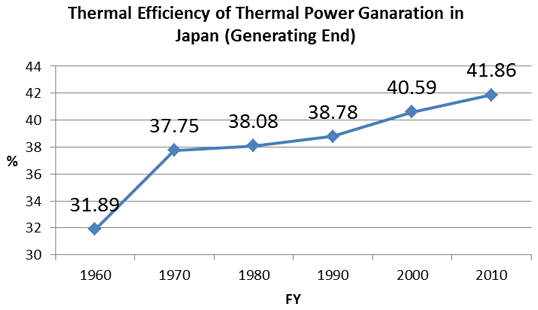
Efforts have been made to ensure safe and comfortable railways, which have substantially less energy intensity compared with other passenger transport means, as shown in Figure 17.
図17にみられるように他の旅客輸送手段より格段に小さいエネルギー原単位を有する鉄道を安全に快適に保つためにも、努力が行われてきた。
Renewable energies contribute to the reduction of CO₂ emissions. The government has been promoting technology development, production, and use of renewable energies. New Energy and Industrial Technology Development Organization is promoting research and development technologies including those for renewable energy sources(注55). Also, electric utilities are obliged to purchase electricity generated by renewable energy sources at specified prices(注56).
再生可能エネルギーは、CO₂排出削減に貢献する。政府は再生可能エネルギーの技術開発、生産や利用を奨励している。新エネルギー産業技術総合開発機構は、再生可能エネルギー等の技術開発を促進している。また、電気事業者は、再生可能電源からの電力を一定の価格で買い取ることを義務づけられている。
However, CO₂ emissions from energy use in Japan have decreased only in the industry sector and have increased in other sectors compared with the numbers in 1990, as shown in Figure 18. It is because that energy consumption in household, commercial and transport sectors has increased, and it is not only a problem for the environment but also the economy and supply security for emergency occasions such as natural disasters. Further efforts are necessary.
しかし、図18にみられるように、1990年の数値と比較すると、日本のエネルギー使用によるCO₂排出は、産業部門でのみ減少し、他の部門では増加した。これは、家庭、商業、輸送部門のエネルギー消費が増えたからであり、環境だけでなく、経済にも、そして災害時などのエネルギー安定供給確保上も問題である。一層の努力が必要である。
Conclusion結論
Water and air pollution in Japan during the 1950s and 1960s imposed very high costs on residents, businesses, and the government of Japan. However, during the 1970s and 1980s, with the introduction of environmental policy measures, Japan's environmental quality improved at the same time as achieving a rapid economic growth. If these actions had been taken earlier, the costs incurred by the pollution could have been reduced substantially.
1950年代から1960年代にかけての日本の水や大気の汚染は、日本の住民、産業、政府に非常に高い費用を課した。しかし、環境政策の導入後、1970年代から80年代にかけて日本の環境は高度成長とともに改善した。もし、より早い時期に行動がとられていたら、汚染によってかかった費用は相当少なくて済んだだろう。
However, challenges in the environment still remain, and efforts must be made in many areas including those to mitigate the climate change. Establishing laws and setting proper standards are only the first step. Laws are only effective after they are properly enforced. Both capacity of public organizations for law enforcement and understanding among the private sector are needed for a successful reduction of pollutants.
しかし、環境の課題は残っており、気候変動を軽減するなど多くの分野で努力する必要がある。立法と適切な環境基準の設定は、第一歩でしかない。法は適切に執行されて初めて効果がある。汚染の低減を成功させるためには、行政機関の法執行能力と民間の理解の双方が必要である。



